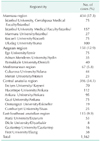1. Bilezikian JP, Meng X, Shi Y, Silverberg SJ. Primary hyperparathyroidism in women: a tale of two cities--New York and Beijing. Int J Fertil Womens Med. 2000; 45:158–165.
2. Yeh MW, Ituarte PH, Zhou HC, Nishimoto S, Liu IL, Harari A, et al. Incidence and prevalence of primary hyperparathyroidism in a racially mixed population. J Clin Endocrinol Metab. 2013; 98:1122–1129.
3. Kirdak T, Duh QY, Kebebew E, Clark OH. Do patients undergoing parathyroidectomy for primary hyperparathyroidism in San Francisco, CA, and Bursa, Turkey, differ? Am J Surg. 2009; 198:188–192.
4. De Lucia F, Minisola S, Romagnoli E, Pepe J, Cipriani C, Scillitani A, et al. Effect of gender and geographic location on the expression of primary hyperparathyroidism. J Endocrinol Invest. 2013; 36:123–126.
5. Nordenstrom E, Sitges-Serra A, Sancho JJ, Thier M, Almquist M. Vitamin d status in patients operated for primary hyperparathyroidism: comparison of patients from southern and northern europe. Int J Endocrinol. 2013; 2013:164939.
6. Griebeler ML, Kearns AE, Ryu E, Hathcock MA, Melton LJ 3rd, Wermers RA. Secular trends in the incidence of primary hyperparathyroidism over five decades (1965-2010). Bone. 2015; 73:1–7.
7. Rao DS, Honasoge M, Divine GW, Phillips ER, Lee MW, Ansari MR, et al. Effect of vitamin D nutrition on parathyroid adenoma weight: pathogenetic and clinical implications. J Clin Endocrinol Metab. 2000; 85:1054–1058.
8. Karakas E, Schneider R, Rothmund M, Bartsch DK, Schlosser K. Initial surgery for benign primary hyperparathyroidism: an analysis of 1,300 patients in a teaching hospital. World J Surg. 2014; 38:2011–2018.
9. Tassone F, Gianotti L, Baffoni C, Visconti G, Pellegrino M, Cassibba S, et al. Vitamin D status in primary hyperparathyroidism: a Southern European perspective. Clin Endocrinol (Oxf). 2013; 79:784–790.
10. Moosgaard B, Vestergaard P, Heickendorff L, Melsen F, Christiansen P, Mosekilde L. Vitamin D status, seasonal variations, parathyroid adenoma weight and bone mineral density in primary hyperparathyroidism. Clin Endocrinol (Oxf). 2005; 63:506–513.
11. Mishra SK, Agarwal G, Kar DK, Gupta SK, Mithal A, Rastad J. Unique clinical characteristics of primary hyperparathyroidism in India. Br J Surg. 2001; 88:708–714.
12. Zhao L, Liu JM, He XY, Zhao HY, Sun LH, Tao B, et al. The changing clinical patterns of primary hyperparathyroidism in Chinese patients: data from 2000 to 2010 in a single clinical center. J Clin Endocrinol Metab. 2013; 98:721–728.
13. Lo CY, Chan WF, Kung AW, Lam KY, Tam SC, Lam KS. Surgical treatment for primary hyperparathyroidism in Hong Kong: changes in clinical pattern over 3 decades. Arch Surg. 2004; 139:77–82.
14. Heath H 3rd, Hodgson SF, Kennedy MA. Primary hyperparathyroidism. Incidence, morbidity, and potential economic impact in a community. N Engl J Med. 1980; 302:189–193.
15. Wermers RA, Khosla S, Atkinson EJ, Hodgson SF, O'Fallon WM, Melton LJ 3rd. The rise and fall of primary hyperparathyroidism: a population-based study in Rochester, Minnesota, 1965-1992. Ann Intern Med. 1997; 126:433–440.
16. Rao DS, Agarwal G, Talpos GB, Phillips ER, Bandeira F, Mishra SK, et al. Role of vitamin D and calcium nutrition in disease expression and parathyroid tumor growth in primary hyperparathyroidism: a global perspective. J Bone Miner Res. 2002; 17:Suppl 2. N75–N80.
17. Oltmann SC, Rajaei MH, Sippel RS, Chen H, Schneider DF. Primary hyperparathyroidism across the ages: presentation and outcomes. J Surg Res. 2014; 190:185–190.
18. Harinarayan CV, Gupta N, Kochupillai N. Vitamin D status in primary hyperparathyroidism in India. Clin Endocrinol (Oxf). 1995; 43:351–358.
19. Mollerup CL, Bollerslev J, Blichert-Toft M. Primary hyperparathyroidism: incidence and clinical and biochemical characteristics. a demographic study. Eur J Surg. 1994; 160:485–489.
20. Vestergaard P. Primary hyperparathyroidism and nephrolithiasis. Ann Endocrinol (Paris). 2015; 76:116–119.
21. Berger AD, Wu W, Eisner BH, Cooperberg MR, Duh QY, Stoller ML. Patients with primary hyperparathyroidism--why do some form stones? J Urol. 2009; 181:2141–2145.
22. Rejnmark L, Vestergaard P, Mosekilde L. Nephrolithiasis and renal calcifications in primary hyperparathyroidism. J Clin Endocrinol Metab. 2011; 96:2377–2385.
23. Chen HH, Chen YW, Wu CJ. Primary hyperparathyroidism in Taiwan: clinical features and prevalence in a single-center experience. Endocrine. 2010; 37:373–378.
24. Silverberg SJ. Vitamin D deficiency and primary hyperparathyroidism. J Bone Miner Res. 2007; 22:Suppl 2. V100–V104.
25. Ozbey N, Erbil Y, Ademoglu E, Ozarmagan S, Barbaros U, Bozbora A. Correlations between vitamin D status and biochemical/ clinical and pathological parameters in primary hyperparathyroidism. World J Surg. 2006; 30:321–326.
26. Boudou P, Ibrahim F, Cormier C, Sarfati E, Souberbielle JC. A very high incidence of low 25 hydroxy-vitamin D serum concentration in a French population of patients with primary hyperparathyroidism. J Endocrinol Invest. 2006; 29:511–515.
27. Jabiev AA, Lew JI, Garb JL, Sanchez YM, Solorzano CC. Primary hyperparathyroidism in the underinsured: a study of 493 patients. Surgery. 2012; 151:471–476.
28. Han G, Wang O, Nie M, Zhu Y, Meng X, Hu Y, et al. Clinical phenotypes of Chinese primary hyperparathyroidism patients are associated with the calcium-sensing receptor gene R990G polymorphism. Eur J Endocrinol. 2013; 169:629–638.
29. Kandil E, Tsai HL, Somervell H, Dackiw AP, Tufano RP, Tufaro AP, et al. African Americans present with more severe primary hyperparathyroidism than non-African Americans. Surgery. 2008; 144:1023–1026.
30. Kim HG, Kim WY, Woo SU, Lee JB, Lee YM. Minimally invasive parathyroidectomy with or without intraoperative parathyroid hormone for primary hyperparathyroidism. Ann Surg Treat Res. 2015; 89:111–116.









 PDF
PDF ePub
ePub Citation
Citation Print
Print




 XML Download
XML Download